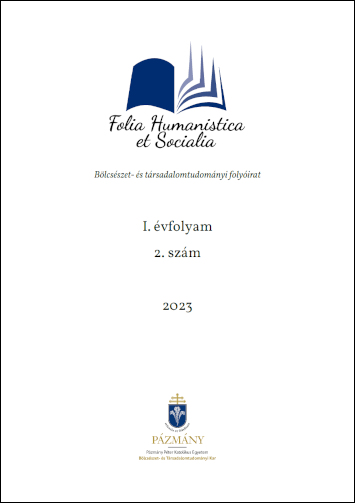A felnagyított tükörkép: művészet, őszinteség és identitás Charlie Kaufman Kis-nagy világ című filmjében
Megjelent 2023-12-31 — Frissítve ekkor: 2024-06-11
Copyright (c) 2023 Cseresnyés Dorottya Mária

This work is licensed under a Creative Commons Attribution 4.0 International License.
Absztrakt
Az 1990-es évek amerikai kulturális gondolkodása egyre inkább elmozdulni látszott a korábbi posztmodern vonulattól. Az Új Őszinteség, illetve a poszt-posztmodern irányzata egy, az irónia külsődleges attitűdje helyett az emberi lét drámáját megértő, az őszinteség igényével fellépő váltást szorgalmazott. Ez a vonulat az amerikai filmművészetben is megjelent az 1990-es évek végétől, többek között Sofia Coppola, Paul Thomas Anderson, Wes Anderson és Charlie Kaufman filmjeiben. Az esszé azt vizsgálja, miként mutatja be Charlie Kaufman 2008-as szerzői filmje, a Kis-nagy világ a posztmodern utáni művész feladatait és kihívásait Caden Cotard alakján keresztül. Ugyan Kaufman filmjének konklúziója szerint a magnum opus és a megismerhetőség eszménye illúzió csupán, csak ez vezetheti el a művészt az emberi kapcsolatok őszinteségéhez, a kortárs szimulált világ egyedüli valóságához.
Hivatkozások
- Baldick, C. (ed.). (2008a). Mise-en-abyme. In The Oxford Dictionary of Literary Terms. Oxford University Press, 211–212.
- Baldick, C. (ed.). (2008b). Synecdoche. In The Oxford Dictionary of Literary Terms. Oxford University Press, 329.
- Baudrillard, J. (1989). Beyond the Vanishing Point of Art. In Taylor, P. (ed.), Post-Pop Art. MIT Press, 171–189.
- Baudrillard, J. (1994). Simulacra and Simulation. (S. F. Glaser, trans.). University of Michigan Press.
- Deming, R. (2011). Living a Part: Synecdoche, New York, Metaphor, and the Problem of Skepticism. In LaRocca, D. (ed.), The Philosophy of Charlie Kaufman. The University Press of Kentucky, 193–206.
- Doyle, J. (2018). The changing face of post-postmodern fiction: Irony, sincerity, and populism. Critique: Studies in Contemporary Fiction, 59(3), 259–270. https://doi.org/10.1080/00111619.2017.1381069
- Gáncsos K. (2013). A nemlétezés téveszméje, avagy a posztmodern valóság, amely csak a hiányában van jelen. Charlie Kaufman Synecdoche, New York című filmjének elemzése [The Delusion of Nonexistence, or the Postmodern Reality That Is Only Present in Its Absence. The Analysis of Charlie Kaufman’s Synecdoche, New York]. Apertúra. https://www.apertura.hu/2013/osz/gancsos-a-nemletezes-teveszmeje-avagy-a-posztmodern-valosag-amely-csak-a-hianyaban-van-jelen/
- Genette, G. (1983). Narrative Discourse. An Essay in Method. (Lewin, J. E. trans.). Cornell University Press.
- Gratton, P. (2020, Winter). Jean François Lyotard. In The Stanford Encyclopedia of Philosophy. https://plato.stanford.edu/entries/lyotard/#JustLighPostCond
- Guillen, M. (2008, October 23). Synecdoche, New York—Interview with Charlie Kaufman. Screen Anarchy. https://screenanarchy.com/2008/10/synecdoche-new-yorkinterview-with-charlie-kaufman.html
- Kaufman, C. (dir.). (2008). Synecdoche, New York [Film]. Sydney Kimmel Entertainment.
- Kellner, D. (2020, Winter). Jean Baudrillard. In The Stanford Encyclopedia of Philosophy. https://plato.stanford.edu/entries/baudrillard/
- Kelly, A. (2016). The New Sincerity. In Gladstone, J. - Hoberek, A. - Worden D. (eds.), Postmodern/Postwar and After: Rethinking American Literature. University of Iowa Press, 197–207. https://doi.org/10.2307/j.ctt20q23p0.15
- Konigsberg, I. (ed.). (1988). Fade. In The Complete Film Dictionary. Bloomsbury Publishing Limited, 111.
- Lyotard, J.-F. (1984). The Postmodern Condition: A Report on Knowledge. (Bennington, G. - Massumi, B. trans.). In Theory of History and Literature, 10. University of Minnesota Press.
- Smith, D. L. (2011). Synecdoche in Part. In LaRocca, D. (ed.), The Philosophy of Charlie Kaufman. The University Press of Kentucky, 239–253.
- Soanes, C., et. al. (eds.). (2008). Simulacrum. In Concise Oxford English Dictionary. Oxford University Press, 1344.
- Wallace, D. F. (1993). E Unibus Pluram: Television and U.S. Fiction. Review of Contemporary Fiction, 13(2), 151–193. https://jsomers.net/DFW_TV.pdf
- Wilkins, K. (2019). American Eccentric Cinema. Bloomsbury Publishing. https://doi.org/10.5040/9781501336942

